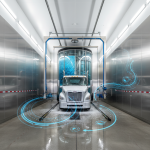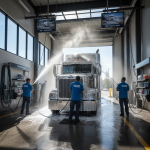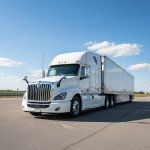Are you looking to open a commercial delivery vehicle wash? Calculating the utility and water costs is a crucial step in ensuring profitability. In this complete guide, we will walk you through the process of determining these costs accurately.
Whether you already have a location or are in the planning stages, understanding how utility and water costs affect your bottom line is essential. From water consumption to electricity usage, we will cover everything you need to know to make informed business decisions.
Our guide will provide detailed information on how to measure water flow rates, how to estimate the number of washes per day, and how to calculate electricity usage. We will also explore ways to optimize water consumption and lower utility bills.
By the end of this article, you’ll have a comprehensive understanding of how to calculate utility and water costs for your commercial delivery vehicle wash. Armed with this knowledge, you’ll be able to make strategic decisions that contribute to the success of your business.
Let’s dive in and get started on optimizing your costs and maximizing your profits.
Importance of calculating utility and water costs
Calculating utility and water costs is a crucial aspect of running a commercial delivery vehicle wash. These costs can significantly impact your profitability and should not be overlooked. By accurately determining your utility and water expenses, you’ll be able to better understand your business’s financial health and make informed decisions to improve efficiency and increase profits.
Understanding how utility and water costs are calculated allows you to identify areas where you can optimize consumption and reduce expenses. This knowledge will empower you to take proactive measures to minimize waste, conserve resources, and ultimately lower your bills.
Factors affecting utility and water costs for commercial delivery vehicle washes
Several factors can influence utility and water costs for commercial delivery vehicle washes. It’s essential to consider these factors when calculating your expenses to ensure accuracy and effectively manage your budget. Let’s explore some key factors that can impact your utility and water costs:
1. Water Consumption: The amount of water used per wash is a significant determinant of your water costs. Commercial delivery vehicle washes typically require a substantial amount of water to effectively clean and rinse vehicles. By accurately measuring water flow rates and estimating the number of washes per day, you can calculate your water consumption and associated costs.
2. Electricity Usage: Commercial delivery vehicle washes rely on various electrical equipment such as pumps, motors, and lighting. These equipment contribute to your electricity usage and can significantly impact your utility bills. Understanding how to calculate electricity costs based on equipment specifications and usage patterns is crucial for accurately estimating and managing this expense.
3. Water Heating: Some commercial delivery vehicle washes use heated water for improved cleaning results. Heating water requires additional energy and can contribute to higher utility costs. By considering the amount of hot water used and the energy required to heat it, you can factor in these costs when calculating your utility expenses.
4. Peak Demand: Utility providers often charge higher rates during peak demand periods. It’s important to be aware of these peak hours and adjust your operations accordingly to minimize the impact on your utility bills. By optimizing your workflow and adjusting wash schedules, you can potentially reduce peak demand charges and save on utility costs.
Understanding these factors and their impact on your utility and water costs is crucial for accurate calculations and effective cost management. Let’s now explore the process of metering utility usage and calculating water costs for commercial delivery vehicle washes.
Understanding utility and water metering
Metering utility usage is a key step in accurately calculating your utility and water costs. Utility meters measure the amount of electricity and water consumed, providing you with the data needed for calculations and cost analysis. Let’s take a closer look at utility and water metering for commercial delivery vehicle washes:
1. Electricity Metering: Your commercial delivery vehicle wash should have an electricity meter that measures your electrical usage. This meter provides valuable information on the amount of electricity consumed during a given period. By regularly monitoring your electricity meter readings, you can track usage patterns and calculate associated costs.
2. Water Metering: Similarly, a water meter measures the volume of water used by your commercial delivery vehicle wash. This meter helps you determine the amount of water consumed per wash and overall water consumption. Regularly recording water meter readings allows you to accurately calculate water costs and identify opportunities for conservation.
It’s essential to keep track of your utility and water meter readings consistently to ensure accurate cost calculations. By using the data provided by these meters, you’ll be able to calculate your utility and water costs more precisely. Let’s now move on to the process of calculating water costs for commercial delivery vehicle washes.
Calculating water costs for commercial delivery vehicle washes
Calculating water costs for commercial delivery vehicle washes involves considering various factors, including water consumption, local water rates, and the number of washes per day. By following this step-by-step process, you can accurately determine your water costs:
1. Measure Water Flow Rates: Begin by measuring the water flow rate for each component of your vehicle wash system, such as the pre-rinse, soap application, and rinse cycles. This can be done using a flow meter or by timing how long it takes to fill a container of known volume. By measuring the flow rates, you’ll have the data needed to calculate water consumption accurately.
2. Estimate Number of Washes per Day: Next, estimate the number of washes your commercial delivery vehicle wash will perform each day. This estimation should be based on your projected business volume and operational capacity. By having a realistic estimate of the daily wash count, you can calculate your daily water consumption.
3. Calculate Water Consumption: Multiply the measured flow rates from step 1 by the duration of each wash cycle to determine the water consumed per wash. Then, multiply the water consumed per wash by the estimated number of washes per day to calculate your daily water consumption. This figure will serve as the basis for calculating your water costs.
4. Consider Local Water Rates: Research the water rates charged by your local utility provider. These rates may vary depending on factors such as the volume of water used and the time of day. By understanding the specific water rates applicable to your commercial delivery vehicle wash, you can accurately estimate the cost of water consumed.
5. Calculate Water Costs: Multiply your daily water consumption by the applicable water rate to calculate your daily water costs. To determine monthly or yearly costs, multiply the daily water costs by the number of days or months in a year, respectively.
By following this process, you can calculate your water costs accurately and gain insights into this significant expense. However, water costs are not the only utility expense to consider. Electricity costs also play a crucial role in the overall operational expenses of commercial delivery vehicle washes.
Calculating electricity costs for commercial delivery vehicle washes
Electricity costs for commercial delivery vehicle washes depend on factors such as the power requirements of your equipment, the duration of each wash cycle, and the electricity rates charged by your local utility provider. Follow these steps to calculate your electricity costs accurately:
1. Determine Equipment Power Requirements: Identify the power requirements (in kilowatts) for each electrical component in your vehicle wash system, such as pumps, motors, and lighting. This information can typically be found in the equipment’s specifications or user manuals.
2. Estimate Daily Electricity Usage: Multiply the power requirement of each electrical component by the duration (in hours) it is used during each wash cycle. Sum up the results to obtain the total kilowatt-hours (kWh) consumed per wash. Multiply this value by the estimated number of washes per day to determine your daily electricity usage.
3. Consider Electricity Rates: Research the electricity rates charged by your local utility provider. These rates may vary depending on factors such as the time of day and the amount of electricity consumed. By understanding the specific electricity rates applicable to your commercial delivery vehicle wash, you can accurately estimate your electricity costs.
4. Calculate Electricity Costs: Multiply your daily electricity usage by the applicable electricity rate to calculate your daily electricity costs. To determine monthly or yearly costs, multiply the daily electricity costs by the number of days or months in a year, respectively.
By following these steps, you can calculate your electricity costs accurately and gain valuable insights into this significant expense. However, it’s important to note that there are additional utility costs that should be considered when determining the overall expenses of operating a commercial delivery vehicle wash.
Additional utility costs to consider
In addition to water and electricity costs, operating a commercial delivery vehicle wash may involve other utility expenses. These costs can vary depending on factors such as your location, the size of your facility, and the specific equipment you use. Here are some additional utility costs to consider:
1. Natural Gas or Propane: If your commercial delivery vehicle wash uses natural gas or propane for water heating or other purposes, you’ll need to factor in the costs associated with these utilities. Research the local rates for natural gas or propane and calculate the expenses based on your usage.
2. Sewer and Wastewater Disposal: Proper disposal of wastewater is essential for maintaining environmental compliance. Depending on local regulations, you may be required to pay fees for sewer connections or wastewater disposal. Research the applicable fees and factor them into your overall utility costs.
3. Solid Waste Disposal: Commercial delivery vehicle washes generate solid waste such as used filters, cleaning materials, and packaging. Proper disposal of these wastes may involve additional costs, such as fees for waste collection and disposal services. Consider these costs when calculating your overall expenses.
By considering these additional utility costs, you’ll have a more comprehensive understanding of the expenses associated with operating a commercial delivery vehicle wash. However, it’s important to remember that reducing utility and water costs is a key objective for optimizing profitability. Let’s explore some strategies to achieve this goal.
Strategies for reducing utility and water costs
Reducing utility and water costs is not only beneficial for your bottom line, but it also contributes to environmental sustainability. By implementing the following strategies, you can optimize your resource consumption, lower your bills, and minimize your environmental impact:
1. Invest in Energy-Efficient Equipment: Consider upgrading to energy-efficient equipment that consumes less electricity and water. Newer models often feature advanced technologies that reduce resource consumption while maintaining excellent cleaning results. Although there may be an initial investment, the long-term cost savings can be significant.
2. Implement Water Recycling Systems: Explore the possibility of implementing water recycling systems in your commercial delivery vehicle wash. These systems capture and treat wastewater, allowing it to be reused for subsequent wash cycles. By recycling water, you can significantly reduce your overall water consumption and associated costs.
3. Install Timers and Sensors: Install timers and sensors on your equipment to ensure they are only operational when needed. For example, you can automate lighting systems to turn off when no one is present, or use sensors to activate pumps and motors only when vehicles are being washed. This minimizes unnecessary energy consumption and reduces utility costs.
4. Educate and Train Staff: Educate your staff on the importance of resource conservation and provide training on efficient operating procedures. By empowering your employees to be mindful of water and energy usage, you can create a culture of sustainability within your commercial delivery vehicle wash.
5. Monitor and Analyze Utility Usage: Continuously monitor your utility usage and analyze the data to identify areas of improvement. Regularly review your meter readings, compare them to previous periods, and look for any anomalies or inefficiencies. This proactive approach allows you to address issues promptly and make necessary adjustments to minimize costs.
By implementing these strategies, you can effectively reduce your utility and water costs while maintaining a high level of service. Remember, optimizing profitability goes hand in hand with minimizing resource consumption and maximizing efficiency.
Tools and resources for calculating utility and water costs
Calculating utility and water costs can be made easier with the help of various tools and resources available. These resources provide valuable insights, calculators, and guidance to ensure accurate calculations and informed decision-making. Here are some tools and resources you can utilize:
1. Utility Rate Calculators: Many utility providers offer online calculators that allow you to estimate your utility costs based on your specific usage and rates. These calculators take into account factors such as water consumption, electricity usage, and peak demand to provide accurate cost estimates.
2. Water Flow Meters: Invest in water flow meters to accurately measure the flow rates of water in your commercial delivery vehicle wash. These meters provide real-time data that can be used to calculate water consumption and associated costs. Choose a flow meter that suits your specific needs and budget.
3. Energy Monitoring Systems: Energy monitoring systems track and record electricity consumption in real-time. These systems provide valuable insights into usage patterns and can help identify areas of inefficiency. By using an energy monitoring system, you can gain a better understanding of your electricity costs and take steps to reduce them.
4. Government and Industry Associations: Government agencies and industry associations often provide resources and guides on utility and water cost calculations. These resources may include best practices, case studies, and tools specific to commercial delivery vehicle washes. Take advantage of these resources to enhance your knowledge and make informed decisions.
By utilizing these tools and resources, you can streamline the process of calculating utility and water costs for your commercial delivery vehicle wash. Additionally, these resources can help you stay up to date with industry trends, regulations, and best practices.
Conclusion
Calculating utility and water costs is an essential aspect of running a commercial delivery vehicle wash. By accurately determining these expenses, you can make informed decisions to optimize your costs and increase profitability. Understanding factors such as water consumption, electricity usage, and additional utility costs allows you to calculate expenses accurately and identify areas for improvement.
Implementing strategies to reduce utility and water costs, such as investing in energy-efficient equipment and water recycling systems, can have a significant impact on your bottom line. By being mindful of resource consumption, training your staff, and monitoring utility usage, you can achieve greater efficiency and sustainability.
Remember to utilize available tools and resources to simplify the calculation process and stay informed about industry trends and best practices. Armed with a comprehensive understanding of calculating utility and water costs, you are well-equipped to make strategic decisions that contribute to the success of your commercial delivery vehicle wash.




